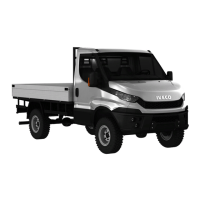DAILY 4x4 ‒ GUIDELINES FOR BODYBUILDERS
CHASSIS INTERVENTIONS
2.11 MODIFYING THE ENGINE COOLING SYSTEM
27
– Printed 692.68.999 – 3 Ed. - Base 08-2020
2.10.2 Engine exhaust (only Euro III)
If it is necessary to change the pipe layout despite the availability of various optional solutions in the catalogue, it is advisable to en-
visage:
● the simplest possible route (curvatures with radii of no less than 2.5 times the outer diameter, passage sections no smaller
than those of the original solution, absence of throttling);
● suitable distances (min. 150 mm) from electrical systems and plastic pipes (shorter distances progressively require plate guards,
thermal insulators or the replacement of plastic pipes with steel ones).
Authorisation must always be obtained from IVECO.
Furthermore, modifications to the silencer body are not permitted.
2.11 MODIFYING THE ENGINE COOLING SYSTEM
The good operating conditions of the original system must not be altered, especially for what concerns the radiator, free surface of
the radiator and pipes (dimension and layout).
In any case, if modifications are required (e.g: cab modifications) that entail interventions on the engine cooling system, keep in mind
that:
● The air passageway area for radiator cooling must not be less than that on vehicles with series standard cabs;
● maximum air expulsion from the engine compartment must be guaranteed, making sure that there are no hot air pockets of
recirculation by adopting guards or deflectors;
● fan performance must not be modified;
● any modifications of the water piping must not compromise complete filling of the circuit (done with a steady flow and
without any backflow from the intake until the circuit is filled) and regular water flow; in addition, these modifications must not
alter maximum water stabilisation temperature, even in the most demanding conditions of use;
●
pipe layout must be done so as to avoid the formation of air pockets (e.g. eliminating siphoning bends or installing required
vents) that may make water circulation difficult;
● check that water pump activation at engine start-up and successive operation during idling is immediate (accelerate a few
times), even when circuit is not pressurised. During checks make sure that the water pump supply pressure, with engine at
top speed and no load, is less than 1 bar.
To check the operation of the cooling circuit we must account for the water supply, bleed and circulation proceeding as follows:
● fill the circuit while the engine is off with a flow rate of 8 - 10 l/min, until water seeps from the overflow vent;
● start the engine and run idle for 5 minutes, successively check to see that the water level in the supply tank has not dropped
below minimum level;
● gradually rev the engine, checking that average pressure in the water pump outlet pipes steadily increases without and discon-
tinuities;
● keep accelerating the engine until the thermostat opens, causing air bubbles to pass through transparent pipes installed
between:
■ engine output and radiator;
■ water supply tank and water pump;
■ engine bleed and water supply tank;
● check, after the thermostat has be open for 15 minutes, that there are no more bubbles in the circuit;
● check that, with thermostat open and engine running idle, that average pressure in the water pump inlet pipe is greater than
500 mm water column (0.05 bar).

